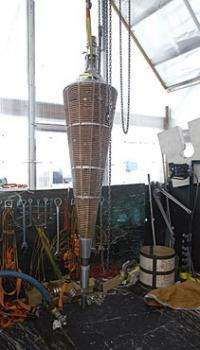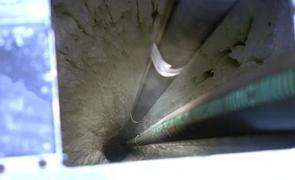Polar neutrino observatory takes a big step forward

An international team of scientists and engineers has taken a major step toward completion of what will be the world's preeminent cosmic neutrino observatory, harnessing a sophisticated hot-water drill to build an observatory under the South Pole that eventually will encompass a cubic kilometer of ice.
Scientists leading a consortium building the massive neutrino telescope known as IceCube say that this year they have nearly doubled the size of the detector now under construction at the National Science Foundation's Amundsen-Scott South Pole Station.
Although work can only take place from October through February-the fleeting and still frigid summer season at the Pole-the extent and pace of construction this year means that the observatory may soon begin scientific operations. IceCube is scheduled for completion in 2011.
"The news is good all around," says Francis Halzen, the University of Wisconsin-Madison physics professor leading the effort.

Halzen and others leading the effort report that IceCube- which depends on strings of light-sensing modules frozen deep in crystal clear Antarctic ice-has grown this austral summer by 480 basketball-sized optical modules. Deployed on long cables in 1.5-mile deep holes bored by a unique hot-water drill, the modules will be used to detect the fleeting but telltale signatures of high-energy cosmic neutrinos as they flit through the Earth.
Neutrinos are ghostly, high-energy subatomic particles created in galactic collisions, distant black holes, quasars and a zoo of the most violent events in the cosmos. They carry information that promises to peel back some of the mystery of the universe's most enigmatic events such as gamma ray bursts, dark matter and supernovas.
But cosmic neutrinos-billions of which pass unnoticed through the Earth and indeed through the human body every day-are, by their very nature, extremely difficult for astrophysicists to detect. What is required is a very large detector to optimize the chances that scientists can catch a neutrino in the act of crashing into a proton or another subatomic particle.
When IceCube is completed, a cubic kilometer of the ice beneath the Pole will have been seeded with more than 4,200 optical sensors to capture telltale traces of the neutrinos and follow their tracks back to their distant points of origin. In addition, another 300 or so sensors will be deployed in tanks on the surface of the polar ice.
Once the holes are drilled, cables with the spherical digital optical modules-which are composed of electronics for sensing light and circuit boards for gathering and processing data-are lowered into the ice, where they are frozen in place. The modules act like light bulbs in reverse, gathering light created when neutrinos collide with other particles. The modules then relay data to the surface where the information is processed and stored for analysis.
When fully operational, IceCube will sample neutrinos from the sky in the Northern Hemisphere. The detector will use the Earth as a filter to exclude other types of neutrinos, such as those from the sun, which could confuse the detector. Its primary scientific mission will be to identify the sources and distribution of the highest energy neutrinos created by violent cosmic events.
IceCube is being constructed around an older, prototype neutrino telescope known as AMANDA for Antarctic Muon and Neutrino Detector Array. IceCube construction began in January 2005 when scientists drilled the first hole for the detector and deployed the first optical modules for the observatory.
"The digital optical modules deployed last year have now functioned for one year without failures," says Halzen. "They perform like a Swiss watch. But the big story of this season is the performance of the drill."
After working out kinks in the performance of the drill last year and at the beginning of the 2005-06 drilling season, and adding an extra drilling tower, the IceCube team was able this year to bore a total of eight deep holes into the Antarctic ice and deploy eight 60-module strings of sensors this season. Combined with the existing AMANDA array, IceCube currently consists of nearly 1,300 optical modules.
Although the new technologies used to create the detector are completely environmentally safe, the engineering challenges of working in the Polar environment-where temperatures fluctuate, on average, from minus 35 Fahrenheit in November to minus 16 Fahrenheit in February-are daunting. Even so, "all the major challenges encountered by drilling a first hole last season have been solved," says Halzen.
The IceCube array now is composed of nine strings and 16 surface detector stations, in addition to the still operational AMANDA array, making a scientific program possible, according to Jim Yeck, IceCube project director.
"We know that there is more work to be done, but let there be no doubt about what a remarkable accomplishment it is to safely install eight strings this season," Yeck says.
The newly installed modules are functioning and sending signals to the surface, Yeck says. IceCube scientists will continue to verify cable connections and surface electronics during the upcoming winter season at the South Pole.
NSF, through a joint program of its Office of Polar Programs and its Mathematical and Physical Sciences Directorate, is contributing more than $240 million to the international partnership that is building the detector, which will cost $272 million overall.
Related link: First critical parts of giant neutrino telescope in place
Source: University of Wisconsin-Madison















